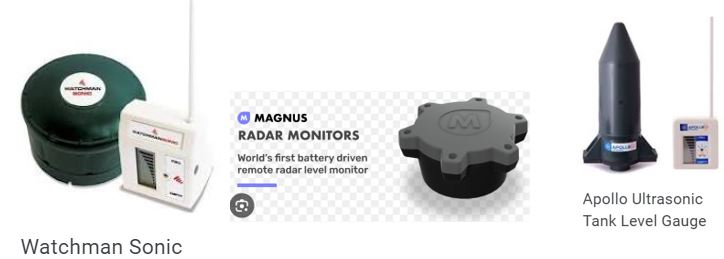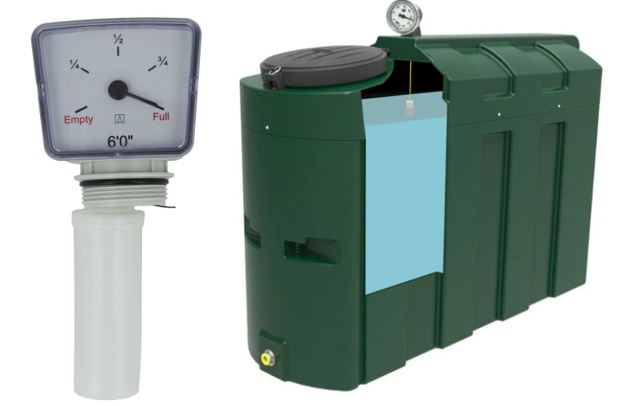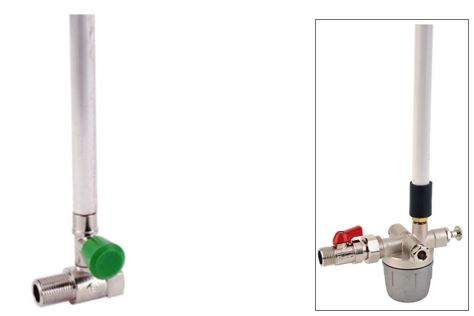Oil tank gauges are commonly used to keep track of and measure the volume of oil that is stored within your oil tank. They are indicators that show how much oil has been added to your tank and how much more is needed. Some of the more modern oil tank gauges even tell you when a refill is required.
There are several commonly used domestic oil tank gauges.
Some of the most popular one’s are listed below:
Electronic gauge
The more modern gauge that operates electronically: ultra-sonic or radar.
Some electronic gauges are wireless, and others can be linked to your mobile phone via an App. Typically, a tank-based oil level transmitting unit is installed which then sends readings to a plug-in display unit that is normally installed in your kitchen or laundry room for convenience (or to a phone App)
Although they tend to be more expensive, the wireless oil tank gauge is the most popular and convenient to use – you don’t even need to go near the tank to check the level of oil.
Typically, the display unit will show 10 bars when full and start flashing / buzzing once your tank reaches 1 bar. People generally order a re-fill from Valueoils.com when the reader shows 2 bars or 20% of tank capacity.
There are various suppliers and manufacturers of such electronic gauges including Sensor systems, Apollo, Magnus monitors.

Basic gauge – older “manual” gauges of which there are 2 types:
Float Clock Gauge
Although float clock gauges are cheaper, there are not so many of these gauges being used today as they are replaced with electronic gauges.
These gauges are more accurate in square or oblong shaped tanks as the tank capacity is evenly spread in the tank.
This gauge is mounted on top of the tank with the display features of a clock face/dial which is attached to a piece of string that operates on a spring loaded, weighted float mechanism. As the level of oil inside the tank drops, the weighted float also lowers which then indicates the approximate level of oil inside the tank and the clock display adjusts to reflect this.
There are also disadvantages of this gauge – the oil can dye the string that it attached to the weighted float which then soaks through the rest of the string and seeps into the clock display causing discolouration and making it difficult to read the oil level.
This type of gauge is not so good for barrel shaped tanks because as the capacity is less at the bottom of the tank, the tank tapers inward. Therefore, when the clock displays ¼ full, this is an inaccurate reading due to the bottom of the tank having a lesser capacity.
Generally, when the oil level is down to ¼ of the tank level, customers re-order heating oil from ValueOils.com

Sight Level Guage
Like float clock gauges, there are not many sight level gauges being installed as often as they are also being replaced with electronic gauges. Sight level gauges are also cheaper than electronic gauges.
Sight level gauges are mounted at the front of the tank at the outlet valve. They have thin transparent tubes and are supported by an aluminium back support which shows the exact level of the oil in your tank, displaying the product level in through the transparent tube. The tube runs parallel to the pipe at the bottom of the tank to the outside, extending up the side of the tank and a float is sometimes placed inside.
These gauges operate with a controlling “pressure press button” or ¼ turn valve lever at the bottom of the gauge – this control needs to be activated prior to taking a reading otherwise the reading will be inaccurate. It is also important to ensure that the control valve remains closed when not in use to prevent potential for accidental spillage if the transparent tube becomes damaged or dislodged.
It is also very important to ensure that the top of the transparent tube is ABOVE the height of the top of the oil tank to prevent leakage when tank is topped-up.
The top of transparent tube should also be sealed to prevent water or moisture intrusion which can discolour the pipe and in extreme circumstances then pass through to feed-line to the boiler (if it by-passes the filter bowls). Over time, the transparent tube can become badly discoloured and difficult or impossible to see any indication of the oil level through the pipe. However, these tubes are replaceable by a heating engineer.

Generally, when the heating oil level is down to ¼ of the tank level, customers re-order heating oil from ValueOils.com



